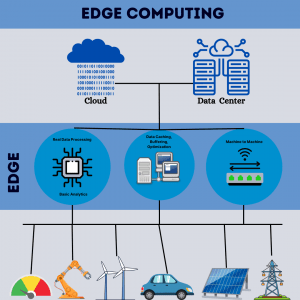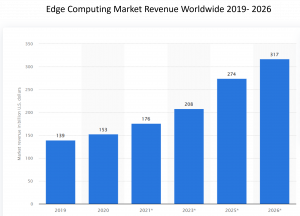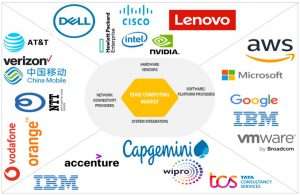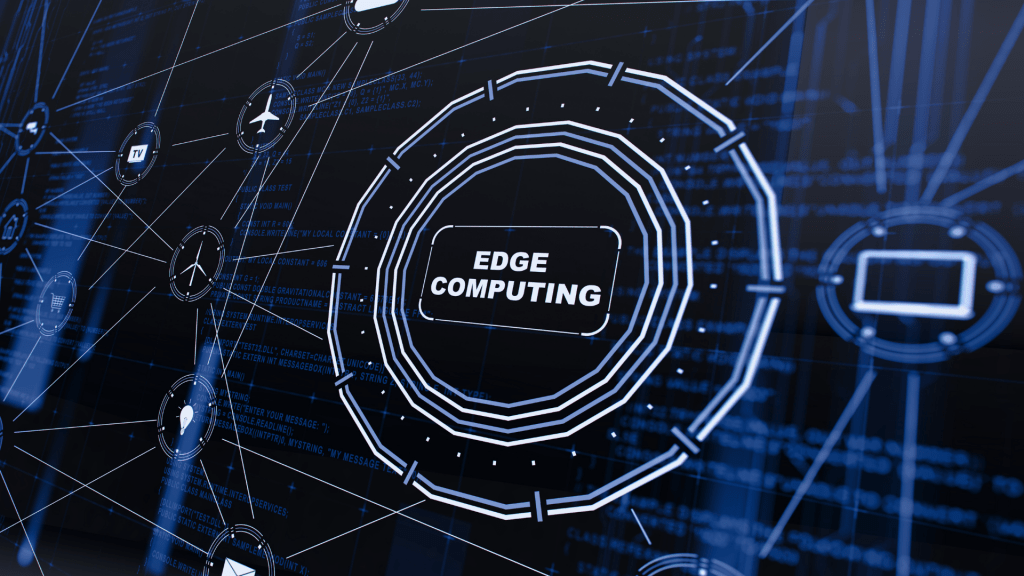Imagine this: You’re online, ready to snag that limited-edition gadget you’ve been eyeing. You pull out your phone, heart pounding with excitement, and… nothing. Your payment gets stuck in a download purgatory, thanks to a spotty internet connection. Sound familiar? In today’s hyper-connected world, even with the promise of blazing-fast 5G morphing into 6G, reliable network connectivity remains an elusive dream for many.
This scenario, all too familiar in today’s connected world, highlights a critical challenge: the limitations of traditional cloud computing. Here’s where a revolutionary concept emerges – edge computing. It’s not just a buzzword; it’s a game-changer poised to eliminate those frustrating network delays and transform everyday experiences like online payments.
This week’s edition of “The People Weekly”, we will dive deep into the world of edge computing and discover how it’s pushing the boundaries of speed, efficiency, and connectivity. With a finger on the pulse of current market trends, it is the constant endeavour of PeopleLogic,
through its publication, “The People Weekly“ to provide our readers with valuable insights so that they can stay ahead of the curve.
What is Edge Computing?
As per Amazon Web Services “Edge computing is the process of bringing information storage and computing abilities closer to the devices that produce that information and the users who consume it.” Traditionally, when you use a web application or service, your request travels to the data centre, the data centre processes the information, and then sends the response back to you.
The explosion of data from technologies like IoT and AI is overwhelming traditional data centres, both on-premise and cloud-based, leading to potential performance bottlenecks. Moreover, it can be expensive and time-consuming to send the large volumes of data to a central location. Also, certain applications require real-time data processing, which isn’t possible if the data has to travel a long distance to a central server.
This is where edge computing shines. As more and more devices are getting interconnected, most of the data is generated and processed at the edge of the network. In edge computing, data which is not required to be processed in the central data centres can be processed at the “edge” of the network i.e at the place where the data is generated- either the device or the local server. This minimises latency (the delay in transferring data across the network).
Imagine a network of sensors monitoring traffic flow in a bustling city. Traditionally, this data would be sent to a centralised cloud server for analysis, causing delays and potential bottlenecks. Edge computing flips this script by placing processing power at the network’s edge – closer to the sensors themselves. In this scenario, the traffic data would be processed locally, enabling real-time traffic management decisions.

Some of the benefits of edge computing are
- Reduction of latency: processing of data close to the source where it is generated will significantly reduce latency and improve speed. This is most important in industrial applications.
- Enhanced Data Security: When the amount of data transferred is minimised due to edge computing, sensitive data is protected against potential cyber attacks.
- Data collection/processing at remote locations: Edge computing makes it possible to collect data from remote locations where the internet collection is not reliable.
- Improved Bandwidth Efficiency: When data transfer to central data centres is minimised then it frees up bandwidth required for critical applications. This is particularly beneficial in areas with limited bandwidth availability.
- Offline Functionality: Edge computing enables devices to continue functioning even with intermittent internet connectivity, ensuring uninterrupted operation in critical applications.
Growth of Edge Computing
The main drivers that have accelerated the growth of edge computing – IoT, 5G and advanced AI.
Increased IoT penetration means more interconnected devices. 5G with its reduced latency and increased bandwidth also is a major driver for the growth and rise of edge computing.
Advanced AI which gives real time data analysis for faster decision making also is a catalyst for edge computing growth.
As per Statista, the worldwide edge computing market is expected to reach 317 billion U.S. dollars by 2026. As per IDC report, edge computing investments will reach USD 232 billion by 2024. This is a 15% increase as compared to 2023.

Edge Computing: Indian Scenario
Recently, Tata Communications launched a fully automated edge computing platform called CloudLyte. In the month of February this year the Swedish firm Ericsson partnered with IIT Kharagpur for research into AI, compute and radio. KaleidEO Space Systems, a Bengaluru based firm, has already demonstrated edge computing in space for taking hi-resolution images, which is ground breaking.
India is a fertile ground for data centres. As per statistics India currently holds 13th position in the total number of operational data centres, with 138 in operation, and an additional 45 new facilities expected by the end of 2025. Thanks to governmental support and push, the data centre opportunity is growing with the capacity expansion which is expected to cross 1,300 MW by the end of 2024, a significant jump from the current 880 MW. There is a clear trend seen in the growth of data centres : growth in demand for colocation data centres and more edge data centres. Right now concentrated in major cities like Mumbai, Bengaluru and Chennai, the newer edge data centres will be located in non metros also.
Edge Computing Use Cases
Edge computing has a wide range of applications across many industries. Here are some key areas where edge computing is making a big impact:
Smart Cities: Traffic management, optimising energy use in buildings, and real-time noise monitoring can all benefit from edge computing by processing data locally and enabling quicker decision-making.
Industrial IoT (IIoT): In factories, edge computing can be used for predictive maintenance by analysing sensor data from equipment to identify potential issues before they cause downtime.
Retail: Edge computing can personalise the shopping experience by analysing customer behaviour in stores and delivering targeted promotions or recommendations.
Healthcare: Wearable health monitors and other devices can use edge computing to analyse patient data locally and trigger alerts for critical situations.
Autonomous Vehicles: Self-driving cars rely on real-time data processing to make split-second decisions. Edge computing allows for processing of sensor data locally to avoid delays in communication with the cloud.
Content Delivery Networks (CDNs): Edge computing can be used to cache content closer to users, resulting in faster loading times for websites and streaming services.
Edge Computing Ecosystem
The edge computing ecosystem is a complex network of interrelated components that work together to enable data processing and storage at the edge of the network.
The key players in edge computing can be found in
- Hardware: Edge Devices, Edge gateways, Edge servers
- Software: Edge operating systems, Edge analytics software, Edge management software
- Connectivity: Network providers, Cellular networks
Services: Cloud providers, System integrators, Edge security providers

Career Opportunities
The rapid growth of edge computing has opened many opportunities for skilled professionals. Some of the sectors which needs professionals for edge computing are
- Manufacturing : The rise of smart factories, powered by the Internet of Things (IoT) and edge computing, is enabling real-time production line monitoring, predictive maintenance, and optimised logistics. This growing trend will drive demand for professionals skilled in edge devices, industrial automation protocols, and data analytics.
- Smart Cities & Infrastructure: The Indian government’s push for smart cities creates opportunities for edge computing specialists to develop solutions for areas like traffic management, waste collection, and smart grids.
- Healthcare: Timely access to medical data is crucial in India’s vast rural areas. Edge computing can enable remote patient monitoring, real-time diagnostics, and faster treatment decisions, creating demand for specialists in medical edge computing solutions.
Skill Sets
- A strong base in edge devices, microcontrollers, and embedded systems is crucial.
- Cloud Computing including containerisation (dockers and kubernetes)
- Data Science & Analytics
- Cyber Security
PeopleLogic Opinion
As the Internet of Things (IoT), 5G networks, and Artificial Intelligence (AI) continue their rapid growth, industries like telecom, manufacturing, and healthcare are increasingly turning to edge computing. This powerful technology isn’t necessarily a “trend” poised to “rule” the IT domain, but rather a crucial piece of the puzzle enabling the next generation of connected experiences.As edge computing matures, it won’t be a solitary force driving innovation, but rather a foundational technology that seamlessly integrates with existing infrastructure. This collaborative approach, alongside advancements in AI and 5G, will empower us to create a more connected, efficient, and ultimately, better world.
As edge computing takes root, hiring the right talent to propel it within your organisation is crucial. PeopleLogic can help. Our expertise lies in identifying the unique skill sets needed – from cloud and networking veterans to AI and IoT specialists. Our 16 year experience in tech hiring helps us to find perfect fits for your edge computing teams. Partner with PeopleLogic to navigate the evolving edge computing talent landscape.






